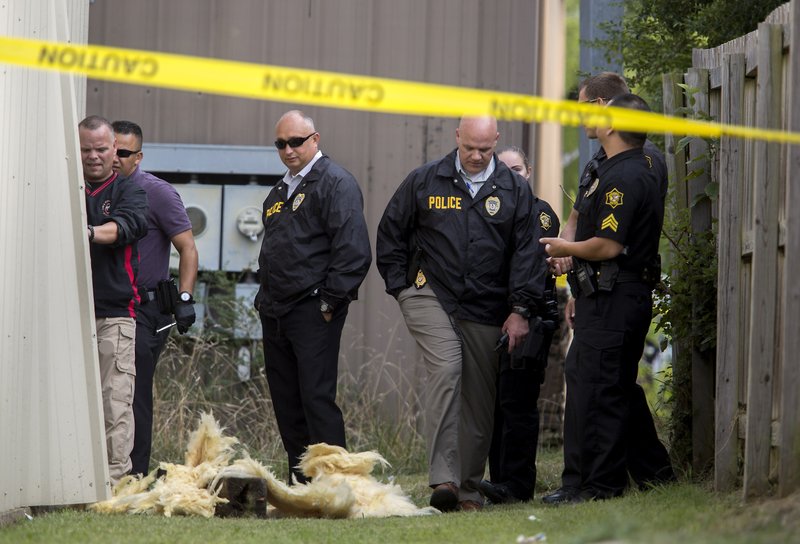SPRINGDALE -- Police officers are expanding an anti-gang education program to all fifth- and seventh-graders in the Springdale School District that's taught in schools across the country.
Officers began to teach the Gang Resistance Education and Training program in at least four schools this week, with other schools beginning next week, Capt. Ron Hritz said.
Gang Resistance Education and Training program
• Started in 1991 by Phoenix Police Department and the Bureau of Alcohol, Tobacco and Firearms
• Program now administered through the U.S. Department of Justice’s Office of Juvenile Justice and Juvenile Delinquency Prevention
• Curriculum for fourth- through eighth-graders, plus a separate program for families
• Emphasizes life skills, including communication, making decisions, setting goals and responsibility
• Considered effective based on a six-year study done by the University of Missouri-St. Louis for the National Institute of Justice
• More than 13,000 law enforcement officers in 50 states, the District of Columbia and Central America certified to teach program
Source: Gang Resistance Education and Training program
"It's not just specifically targeting gangs," Hritz said.
The lessons focus on life skills, including making good choices, and give children a chance to interact with police officers, Hritz said.
"They'll feel comfortable being around a police officer," Hritz said. "They'll come and report things."
Chief Mike Peters told a group of parents and community members attending the School District's Patron Shelf meeting Monday the department has approached the policing of gangs from a variety of angles, including the addition of more school resource officers, active monitoring of social media and the expansion of the anti-gang education program.
The group also learned about a change in School District policy allowing administrators to discipline students for gang-related activity that occurs on social media and off school grounds.
Springdale police have investigated four shootings this year police have described as gang-related, with some of the incidents involving teens. Shootings in March and April killed two and a shooting in June injured a boy riding a bicycle.
The most recent shooting occurred in August during the first week of the school year near Springdale High School. Police have said both the accused shooter and 16-year-old victim were Springdale High School students.
For the past several years, 10 officers have been assigned as school resource officers within the Springdale School District, which pays part of their salary, Peters said.
Hritz applied for a U.S. Department of Justice grant in May 2014, which allowed the department to add seven more school resource officers this school year, bringing the total to 17, he said. The grant provides $563,094 in federal funding to pay salaries and benefits for three years. The department is required to maintain those positions for at least one more year after the grant expires.
Officers funded by the grant must spend 75 percent of their time on school grounds and 25 percent of their time in neighborhoods, Peters said.
Springdale police have taught the anti-gang education program for the past several years, but because just three officers were certified to teach it, their reach was limited to a small number of schools, Hritz said.
Nine more officers were certified to teach the program this summer, he said. The program now will be taught at all elementary and middle schools in Springdale.
The Gang Resistance Education and Training Program was started in Phoenix with a federal grant, Phoenix police Sgt. Kevin Bryce said. The elementary curriculum consists of six lessons designed to help children say no, to set goals, to stand up against bullying and to avoid becoming bullies, Bryce said.
The middle school component also focuses on life skills, with attention on decision-making, controlling anger and calming others, but it also discusses the myths and realities of gangs, Bryce said.
"They do a lot of role-playing," Bryce said.
The National Institute of Justice commissioned the University of Missouri-St. Louis to study the effectiveness of the program in its three goals: reducing gang membership, reducing juvenile crime and violence and improving children's attitudes about police, according to a report published in 2013.
Researchers used a randomized control trial involving 3,820 students in 195 classrooms in 31 schools in seven cities, according to the study. The study included interviews and surveys of students, teachers, school administrators and law enforcement.
Students involved in the anti-gang education program reported more positive attitudes about police, less positive attitudes about gangs, more resistance to peer pressure, less anger and lower rates of gang membership, according to the study.
Parent David Bates remembers feeling concerned about the Springdale shootings, but said he has faith in the police and in the officers working in the schools. He often notices how intentional officers are in getting to know students and sees students giving school resource officers high fives and hugs at football and volleyball games.
Bates said he supports efforts to provide the officers with more support, money and resources. He thinks local, state and federal law enforcement should have plans to anticipate and stop gang violence before it happens.
"You've got to beat it at the point of attack so they can't spread and recruit more of these kids and influence them in making bad decisions," Bates said. "You've got to save them on the front end."
NW News on 10/01/2015

